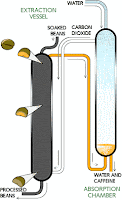It is the roasting of the coffee beans that produces that wonderful coffee aroma and taste by causing the green beans to expand, thereby changing in color, taste, aroma, and density. Coffee that is brewed shortly after the beans are roasted is coffee at the peak of its flavor. ...and that enticing aroma....
Much of coffee is roasted on a large scale commercially although an increasing number of coffee drinkers roast their coffee at home to maintain more control of the freshness and flavor of their coffee beans.
The most common roasting machines are drum and hot-air, although other types include packed bed, tangential, and centrifugal roasting machines. Roasting machines may operate in either a batch or a continuous mode.
Drum Roasting Machines
 |
| Commercial Drum Roasting Machine |
 |
| Home Drum Roasting Machine |
Drum machines have horizontal rotating drums that tumble the green coffee beans in a heated environment. This heat source is natural gas, liquefied petroleum gas (LPG), electricity, or wood. The most common drum roasters use indirectly heated drums with the heat source beneath the drum.
 |
| Hot-air home roasting machine |
 |
| Hot-air commercial roasting machine |
What exactly is “Degree of Roast” ?
So, long does a coffee bean need to roast? Can it be too roasted?
How does one know when a coffee bean is “done”?
How does one know when a coffee bean is “done”?
Coffee roaster masters use a variety of names such as City Roast or French Roast to identify the various degrees of roast. Roastmasters often use a recipe to highlight certain flavor characteristics. A coffee bean’s origin, variety, processing method or desired flavor influence the recipe a roastmaster chooses.
The degree of roast can be determined by eye although this is not the most accurate method. As beans absorb heat, this color shifts – from yellow to increasingly darker shades of brown. Beans also darken as they age, however, so color alone may not be the best way to determine level of roast. Most roasters use color, bean mass temperature, smell, and sound as they monitor the roasting process.
Beans make sounds during the roasting process, as these sounds indicate their internal temperature. Roastrmasters listen for two temperature thresholds, called “cracks.” At approximately 401-405 degrees F beans make a cracking sound, similar to that of a piece of popcorn popping. This is referred to as the “first crack,” the beginning of light roasts. At 435-441 degrees F, coffee beans give a “second crack, the dividing line between medium and dark roasts.
The following are basic levels of roasting coffee beans:
These green coffee beans are ready to be shipped or roasted and can be stored for up to 2 years.
These yellow-tan coffee beans are in the drying stage. They have been in the roasting machine for 8 minutes and are not yet ready to be used to brew coffee.
These light roast coffee beans are just at the first "crack." They can be used for brewing, but make a very weak “coffee tea.”
These city roast coffee beans have finished with their first crack and almost ready to begin their final crack. The coffee brewed from these beans is very balanced and complex – plain coffee. Great for coffee with no cream or sugar.
These Vienna roast coffee beans are about 1 minute after the second crack begins. The resulting coffee is plain, strong coffee - perfect with milk, cream, or any flavoring.
These French roast coffee beans usually occur 3 minutes after the second crack begins. The resulting beans are great for espresso.
 |
| Green Coffee Beans |
These green coffee beans are ready to be shipped or roasted and can be stored for up to 2 years.
 |
| Yellow-tan Coffee Beans 329 degrees F |
These yellow-tan coffee beans are in the drying stage. They have been in the roasting machine for 8 minutes and are not yet ready to be used to brew coffee.
 |
| Light Roast Coffee Beans 401 degrees F |
These light roast coffee beans are just at the first "crack." They can be used for brewing, but make a very weak “coffee tea.”
 |
| City Roast Coffee Beans 428 degrees F |
These city roast coffee beans have finished with their first crack and almost ready to begin their final crack. The coffee brewed from these beans is very balanced and complex – plain coffee. Great for coffee with no cream or sugar.
 |
| Vienna Roast Coffee Beans 437 degrees F |
These Vienna roast coffee beans are about 1 minute after the second crack begins. The resulting coffee is plain, strong coffee - perfect with milk, cream, or any flavoring.
 |
| French Roast Coffee Beans 464 degrees F |
Impact of Roasting on Caffeine Level
The degree of roast also impacts the amount of caffeine, with the amount of caffeine decreasing as the level of roasting increases: 1.37% for a light
roast, 1.31% for a medium roast, and 1.31% for a dark roast. The grind you
choose and the method of brewing can also impact the amount of caffeine.
NEXT: Grinding the Beans





















